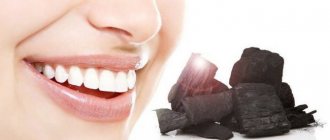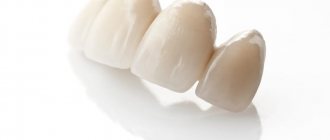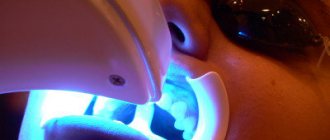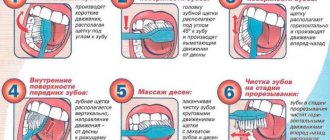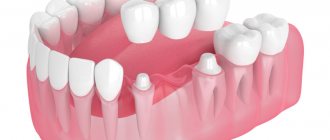Now many people are thinking about teeth whitening, and they can be perfectly understood: a beautiful smile will highlight any image and make a person more presentable. But it happens that a person has several artificial crowns and thinks about whitening tooth enamel. Then the dentist is asked the question: “Is it possible to whiten metal-ceramic crowns?” The only possible answer is: no! This is due to the fact that bleaching agents only affect natural enamel. Such products cannot lighten orthopedic structures.
If you plan to install crowns, then whitening should be done before prosthetics. When the enamel becomes lighter, you can begin installing orthopedic structures. Then the smile will be evenly snow-white, since the orthopedist will select the color of the ceramic coating to match his own enamel. Is it possible to whiten metal-ceramic crowns after they are installed? Answer: no! Here you can either accept it or completely change the design, which will require large financial investments.
Metal-ceramic crown
Modern materials used to make crowns are extremely durable and resistant to dyes. They are quite smooth and non-porous, so pigments cannot penetrate their structure. This is what allows you to limit yourself to daily oral hygiene using a toothbrush and regular paste.
If the material does darken, it is unlikely to be bleached. Metal-ceramics is a very hard and dense material in its structure; none of the modern brightening agents is able to penetrate inside it. In this case, it is possible to talk only about slight lightening, but not about whitening by several tones.
If the crowns are located on the side of the chewing teeth, then nothing will hinder the whitening of the smile area. Moreover, even a strong difference in shades will not affect the patient’s appearance in any way, because others simply will not notice it.
Is it possible to whiten teeth at home?
To maintain the natural whiteness of your teeth, it is important to brush them twice a day with a properly selected brush and toothpaste, rinse your mouth after every meal, use floss and antibacterial rinses, give up cigarettes and coffee, and undergo a professional procedure. hygiene every six months.
But if you naturally have a slightly yellowish or grayish tint to your enamel, even following all of the above measures will not be able to ensure an impeccably white smile. To do this you will have to resort to bleaching. This can be done at home in several ways:
- pencil - brightening gel is produced in a special tube, at the end of which there is usually a soft brush, brush or sponge for convenient application of the composition to the enamel surface. You must use the whitening pencil strictly according to the instructions. Typically, the gel is applied twice in the morning and evening for 2 weeks.
- strips and aligners - the gel can be immediately applied to the strips, which should be glued to the outside of the teeth for a certain time. Other systems include special mouth guards. Their inner surface must be independently coated with a lightening composition and then put on the dentition,
- abrasive pastes - they usually contain coarse abrasive particles, due to which the whitening effect is achieved. However, you cannot use them on an ongoing basis, otherwise you can damage the enamel, which will lead to its weakening and increased sensitivity - the development of hyperesthesia.
When whitening at home, a tray with a special gel is often used.
Before trying any of the methods described above, you should definitely consult a doctor. The specialist will conduct a visual inspection and determine the current condition of the enamel, and give his recommendations on choosing the appropriate system. If the enamel is weakened, thinned or too sensitive, the use of whitening strips and abrasive pastes is strictly contraindicated.
Ultrasonic cleaning of the oral cavity and results
You can lighten artificial dentures a little and restore the attractiveness of your smile with the help of professional cleaning. The whole point of this method is to eliminate plaque, tartar, food particles and deposits that have accumulated on the surface. Currently, specialists use a variety of methods for processing enamel; ultrasonic scalers are in great demand.
This method involves the use of a special device through the tip of which ultrasound and microvibrations are applied. They are capable of destroying even the hardest plaque in just a few seconds without much effort. Simultaneously with ultrasound, the device delivers a stream of water, due to which the enamel is protected from overheating, and crushed particles of contaminants are washed out from its surface.
Dental clinic specialists strongly recommend cleaning your mouth at least once every six months; this will protect the enamel from the accumulation of hard stone and preserve the health of your teeth for a long time. However, this procedure is also ineffective in whitening fillings and crowns.
Care instructions
Despite the fact that metal-ceramic teeth do not require special care, they must be cleaned daily and thoroughly, this is the only way to be sure of a long service life of the prosthesis without unpleasant surprises. Simple but effective recommendations for caring for dentures:
- crowns must be cleaned using vertical sweeping movements from the gums to the cutting edge,
- choose a brush with soft bristles so as not to injure the mucous membrane. It is recommended to use an irrigator.
- if most of the series are dentures, give preference to toothpastes with plant extracts that care for gums,
- be sure to use dental floss to clean the interdental spaces where a lot of plaque accumulates,
- It is advisable to use disinfectant rinses,
- Smokers and coffee lovers should definitely have their teeth professionally cleaned by a dentist, as nicotine and caffeine leave a permanent plaque on teeth and crowns. Whitening pastes will not affect crowns in any way; you should not purchase them.
If possible, buy an irrigator. This is a special device that creates a thin stream of water under high pressure, washing away plaque and food debris from the most inaccessible areas. The irrigator also provides effective massage of the gums, cleanses the tongue and mucous membranes.
Installation of veneers and lumineers
As mentioned earlier, ceramic and plastic crowns are practically not amenable to any of the modern methods of whitening; they can only be cleaned of dirt accumulated on the surface. That is why many patients prefer using more advanced methods of dental restoration, for example, installing veneers.
Veneers are invisible overlays on the frontal area of the teeth, which are fixed using a special dental glue. With their help, you can easily disguise small chips, cracks, darkening of the enamel, as well as slight curvature and even gaps between teeth. These linings are made from very durable and resistant to external influences materials.
An even more reliable and aesthetically attractive option is lumineers. These are exactly the same pads, but thinner. Thanks to this, pre-grinding of the units is not required. Each of these prosthetic options involves taking impressions of the jaw, on the basis of which the onlays themselves are subsequently made. Quite often, doctors prefer to install veneers directly, that is, using a composite material and directly in the patient’s mouth.
Service life of metal-ceramic products
Some patients are mistaken in believing that a metal-ceramic crown will last the rest of their life. Despite the strength and wear resistance, even the operation of this type of product has limitations.
Metal-ceramic dentures, which are based on simple metal, last approximately 10 to 12 years. If an alloy of gold and platinum was used for the frame, the service life will be 15 years, and sometimes more.
The service life of a metal-ceramic prosthesis, like any other, largely depends on the correctness of its manufacture and the patient’s compliance with all the rules for the care and use of this design.
Prevention
To ensure that fillings and crowns do not change their color or lose their attractiveness over time, it is very important to properly care for them. Care involves daily oral hygiene (morning, evening, and after each meal). It is also very important to remember to visit your dentist regularly for checkups.
In addition to the timely detection of enamel and gum diseases, the doctor can carry out preventive cleaning. If a patient has a bridge installed in their mouth, they should rinse the area between the crown and the gum tissue as often as possible. In this case, you can use a device such as an irrigator.
Other recommendations include abstaining from eating solid and coloring foods, strong coffee and black tea, red wine, quitting smoking and other bad habits. It is important to avoid strong temperature changes, as this can lead to loosening of the material and its darkening in the future.
previous post
Is it possible to treat teeth with stomatitis?
next entry
Reasons for discoloration of prosthetic structures
Immediately after installation, dentures look attractive, but over time their aesthetics often decrease. The reason for this may be poor quality materials. If acrylic or nylon with an insufficiently dense structure are used for manufacturing, then dyes easily penetrate into the existing micropores. And then, with each use of colored products, the aesthetic characteristics of the prosthesis decrease: its surfaces darken and lose their shine.
But even high-quality structures can gradually change their color. Reasons for this:
- Incorrect use of the prosthesis. In particular, you should not immediately eat cold foods after hot foods.
- Insufficient care. The structure cannot be cleaned with abrasive powders. You should also not neglect hygiene procedures. Poor cleaning contributes to the formation of a bacterial film on artificial teeth and gums.
- Violation of the composition of microflora in the oral cavity. It is bad if the balance shifts in favor of pathogenic microorganisms. In this case, the prosthesis can quickly become covered with a dark coating produced by certain types of bacteria.
How to contact exactly the one who can give you the right advice about veneers or whitening?
A little bit of my advertising and let's continue:
I, an orthopedic dentist with more than 10 years of successful experience, Sergey Samsakov, will help restore the aesthetics of the frontal units, correct deficiencies in a way that will be appropriate in your case. I will perform unique individual veneers, or carry out a professional cleaning procedure using ultrasound and/or Airflow technology. Sign up for a consultation and we will choose a way to make your smile area beautiful and healthy. Look what beautiful smiles have already found their patients:
A smile is our everything! Where are we now without an image, huh?
The health and aesthetics of the smile area are important both as an image component and as an opportunity to preserve natural teeth and prevent their premature destruction. A question asked by patients: “Is it better to get veneers or teeth whitening?” not entirely correct. There are situations when only veneers will help or the natural shade of enamel can be returned by performing a professional hygiene procedure. It all depends on the condition of the teeth and the result the patient wants to achieve.
To make the right choice, be sure to listen to your dentist's recommendations.
What is laser whitening? Is it true that it is the most effective?
Laser whitening/photo whitening (I came across other names) - all of this is essentially the same thing. In order to stand out from the crowd and offer patients something “unique... and only here,” clinic advertisers come up with a bunch of names for the same procedure. All this is standard whitening with gels, which are activated by the light of special lamps. Indeed, such systems (Zoom, LumaCool, LumaArch and many others) give the fastest and most noticeable results. But at the same time they also give the greatest number of cases of the development of very intense hypersensitivity. Plus, due to the rather high cost of consumables required for each procedure, the high cost of the lamp itself, which must be “beaten”, the price for such a service turns out to be the highest of all possible options for whitening procedures. But the choice is ultimately yours. Do you want instant results visible to the naked eye? Pay with money and discomfort from pain. Do you want it cheaper and with a minimum of discomfort? Then be patient and forget about “laser” whitening.
The generation of advertisers who grew up watching Star Wars apparently imagines the dentists of the future in this way, luring patients to clinics for “laser treatment of caries,” “laser whitening,” and “laser implantation.”
In fact, this is what the Zoom lamp for “laser” (i.e., actually conventional, light-activated) whitening looks like these days.
Other whitening techniques using restorations
- Veneers
are overlays made of ceramic, porcelain or composite materials up to 1.5 millimeters thick that replace the outer layer of teeth. Unlike lumineers, they allow you to change the shape of your teeth, hide chipped enamel and even correct minor bite defects, but require preliminary grinding of the enamel. - Ultraneers
are medium-thick plates (thinner than veneers, but thicker than lumineers) up to 0.5 millimeters. Used to restore aesthetics and correct enamel defects. Unlike lumineers, which are placed on at least 8 teeth in a row, they are suitable for local elimination of defects. - Componeers
are a new class of plates that are made from a nanohybrid composite. This restoration method provides high aesthetics and durability, but also requires preliminary grinding of the enamel.

